|
Itchy eyes are a common symptom that can be due to conjunctivitis, dry eyes or blepharitis (inflammation of the eyelash follicles.) When it becomes a frequent trouble, allergic reaction of the conjunctiva should be considered.
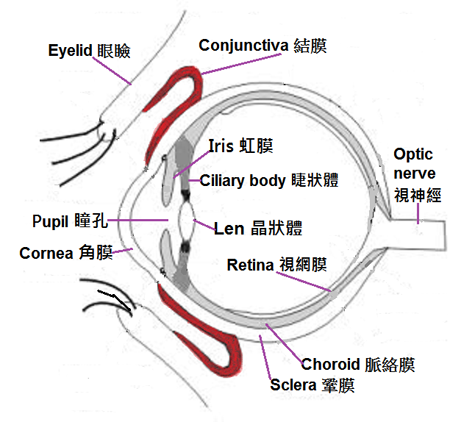
Structures of the eyes
|
Itchy eyes are a typical feature of allergic conjunctivitis. Individuals often accompany with other eye symptoms like redness, tearing, soreness, burning or painful sensations, excess discharges, sensitivity to light and swollen eyelids. The intensity can vary from person to person. When itchy eyes appear at certain period of year such as in spring and fall seasons, seasonal allergic conjunctivitis is diagnosed, and the allergens are likely to be pollen from grasses, weeds, and trees. Perennial allergic conjunctivitis is referred to itchy eyes that happen all year around, which usually indicated a constant exposure to household allergens such as dust mites, mold or pet dander. Some individuals may also be sensitive to contact lens solution, makeup, smoke, or eye cream. It is not uncommon for individuals to have other allergic symptoms, such as nasal congestion, runny nose and sneezing.
Do not rub the itchy eyes, this only makes them worse. Many OTC products can provide a quick relief, however, it is more important to find out what caused the irritations and avoid the triggers as possible as you can. If necessary, seek advice from your doctor about preventive measures and products that work best for you.
Allergic conjunctivitis is likely to recur, if the symptoms are so disturbing, can't improve by self-help measures, then it's time to look for medical intervention. Traditional Chinese medicine (TCM) can be an alternative treatment in such cases.
From a TCM holistic view, the condition of the eyes is associated with internal organs. The eyes rely on essence of the organs for nourishment, when the organs are under-functioning and fail to nourish the eyes, normal eyesight will be affected, and it may even result in eye diseases. During an eye consultation, TCM physicians will check different parts of the eyes, and correlate them with particular organs, which is a unique eye diagnostic method.
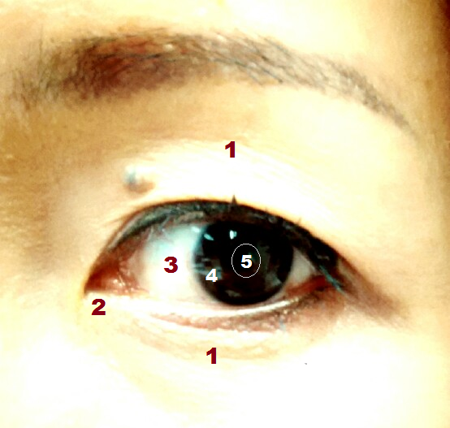
The Five-wheel diagnosis of TCM
|
|
TCM names |
Parts of the eyes |
Corresponding organ systems |
1 |
Flesh wheel |
Eye lids |
Spleen (spleen dominates muscles) |
2 |
Blood wheel |
Skin fold in the inner angle of eyes |
Heart (heart dominates blood) |
3 |
Qi wheel |
White part of the eyeballs |
Lungs (Lungs dominate qi) |
4 |
Wind wheel |
Black part of the eyeballs |
Liver (Liver dominates wind) |
5 |
Water wheel |
Pupils of the eyes |
Kidney (kidney dominates water) |
Based on these relationships between the eyes and organs, physicians can identify what organ has involved in an eye problem. Then they will combine other diagnostic routine to get a comprehensive evaluation for patients and guide the clinical treatment.
Syndrome differentiation treatment for itchy eyes
In TCM understanding, allergic conjunctivitis is regarded as a "qi wheel problem" of the eyes that may develop in the following ways:
 Protective qi of lungs is weak that leads to external wind and heat pathogens attacking the eyes. Protective qi of lungs is weak that leads to external wind and heat pathogens attacking the eyes.
 Stomach and spleen dysfunctions that lead to damp-heat accumulation internally. Meanwhile external wind pathogens take advantage to attack the eyes and trigger the itchy symptom. Stomach and spleen dysfunctions that lead to damp-heat accumulation internally. Meanwhile external wind pathogens take advantage to attack the eyes and trigger the itchy symptom.
 Liver blood insufficiency that generates wind pathogens internally to attack the eyes. Liver blood insufficiency that generates wind pathogens internally to attack the eyes.
Generally, TCM believes that development of allergic conjunctivitis is mainly determined by constitutional factor, external or environmental factors are merely the triggers. Since it is hard for the individuals to avoid the external triggers completely, itchy eyes are likely to be a constant trouble for them. They should seek relief in the earliest possible once the symptom appear. TCM wind dispelling therapy is effective to arrest itchy eyes, including both oral and external remedies. It can also be a routine for prevention that treated between the outbreak periods to reduce the frequency and severity of the allergic attacks.
TCM physicians will examine the patients and ask them about the symptoms, medical history, diet and lifestyle, and then select remedies according to the details. Common disharmony patterns and the herbal remedies for itchy eyes are as below.
Wind-heat attacking eyes
Severe itchy eyes that accompany with gritty, burning or slight painful sensations, the inner eyelids have sandpaper-like rash, and there are also red eyes, weeping, sticky mucous production and possibly blurred vision. The symptoms are worse in windy, shiny and hot environments. The tongue is red with thin coating, and the pulse is rapid. TCM remedy will aim to disperse wind, clear heat, activate blood and resolve stagnation.
Sample of prescription: modified Quick Wind Dispersing Powder (qu feng yi zi san)
Damp-heat in qi wheel
The eyes are itchy and gritty, and have excessive tear and mucus, and the inner eyelids appear sandpaper-like rash. There are also red eyes, blurred vision, scanty hot urination, red tongue with yellow greasy coating, and the pulse is rolling and rapid. TCM remedy will aim to clear heat, dispel dampness, disperse wind and stop itching.
Sample of prescription: modified Ledebouriella Powder to Unblock the Superficial (fang feng tong sheng san)
Blood deficiency and wind attacking
The eye Itching is mild and intermittent, slightly blood-shot or no visible changes in the eyes. Individuals may also have pale nails, dream-disturbed sleep, a pale tongue, and taut and thready pulse. TCM remedy will aim to nourish blood, extinguish wind and stop itching.
Sample of prescription: Four-substance Decoction plus ledebouriella root, Dahurian angelica root, silkworm, caltrop fruit, and centipede
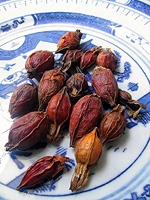 |
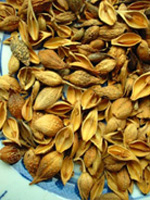 |
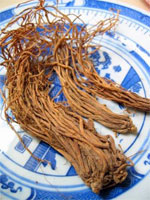 |
| Gardenia fruit |
Weeping forsythia capsule |
Chinese gentian root |
External herbal remedies for itchy eyes
For itchy eyes, it is popular for TCM physicians to use external remedies to treat the eye problems. Herbal remedies that applied in the forms of eye drop, powder, wash or dressing, can unblock meridian collaterals, soothe redness and swelling, arrest weeping and stop itching.
(I). Eye washes
The above anti-itch prescriptions are usually provided for oral intakes, however they can also be used for eye wash or cold compression, so as to soothe the irritated eyes and flush out allergens during attacks. Some other prescriptions for this propose are:
 |
Ledebouriella root, Chinese gentian root, Manchurian wildginger and liquorice root, for 15g each. |
 |
Ledebouriella root, sopora root, dictamnus root bark, Chinese ash bark, and Chinese gentian root, for 15~20g each. |
Application: boil with 500ml of water to make a solution, steam the eyes (blink frequently) when the solution is hot and then wash the eyes when the solution turns cool. Each time takes about 20 to 30 minutes to do this, twice a day.
(II). Nasal therapy
Nasal therapy can be used to relive the symptoms of conjunctivitis. This method involves blowing or inhaling fine herbal powder into the nasal cavities, so that it works on the nasal membrane to treat diseases. It is suitable for disorders of the ear, nose, eye or other head regions. Physicians will prepare a herbal powder according to individual condition. Below are suitable herbal powders for itchy eyes:
 |
Small centipeda herb, grind into fine power and store in a container. |
 |
Small centipeda herb, natural indigo and Sichuan lovage rhizome, combine in 2:1:1 ratio of amount, grind into fine powder, and store in a container. |
 |
Frankincense, myrrh, golden thread rhizome, realgar and sodium sulfate, combine in equal amount, grind into fine powder and store in a container. |
Application: every time, clean the nasal cavities with saline, take 0.3 g of the powder, blow or spray into the nose, do this 3~5 times a day. It is advised to hold some water in mouth beforehand, so as to prevent inhaling the powder mixture into the lungs. If the symptoms are not better after several treatments, or even feel worse, individuals should stop the therapy right away.
Acupuncture therapy for itchy eyes
Acupuncture therapy is applied for allergic conjunctivitis sometimes. Needling stimulations along with moxa warming on appropriate body points can unblock and smooth meridian circulation, harmonize blood and qi flows, so as to inhibit the allergic responses, reduce eye redness and swelling, arrest weeping and stop itching.
The body points for itchy eyes are cheng qi (St 1), tong zi liao (Gb 1), guang ming (Gb 37), yang ling quan (Gb 34), wai guan (Sj 5), da ling (Pc 7), he gu (Li 4). Stimulating with even techniques, and then retaining the needles for 20~30 minutes. Apply daily or every two days, ten days are as one course of treatment.
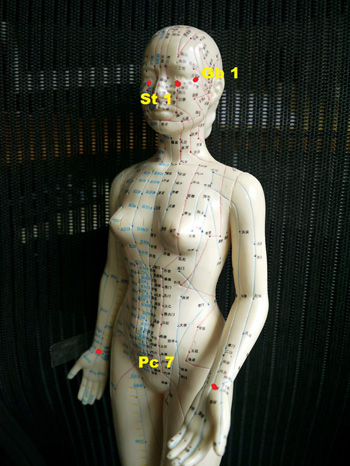
Acupuncture points for itchy eyes
|

Acupuncture points for itchy eyes
|
Healthy tips for itchy eyes
For those who are frequent troubled by allergic conjunctivitis, how to reduce exposure to the common allergens is the key. Practical measures such as wearing sunglasses in outdoors, taking a shower after being outdoor, staying indoors during pollen season and keeping the living environment clean are necessary.
TCM also recommends taking a plain and easily digested diet, in order to keep a tranquil and undisturbed internal environment. Fresh fruits and vegetables are favorable, in particular lotus root, tomato, wild rice stem, Chinese water chestnut, chrysanthemum, medlar head, carrot, mung bean, wax gourd, cucumber, bitter gourd, green plum, pineapple, reed rhizome, and arrowhead, that are helpful to reduce the inflammatory reactions. Foods like mutton, yellow croaker, ribbonfish, shrimp, crab, animal organs, chicken wing and leaf mustard may trigger or aggravate itchy eyes in many individuals, and so are advised to be limited during attacks. Spicy, hot and pungent foods such as hot pepper, onion, garlic, leek and mustard, as well as alcohol and smoking are stimulating in properties, and thus should also be cut down.
It should be noted that supplements are not very suitable during attacks, tonics or herbs in hot property such as ginseng, astragalus root, rehmannia root, aconite root, dried ginger, cassia bark and cassia twig may aggravate itchy eyes. On the other hands, between the attacks, individuals are suggested to take tonics for replenishing qi and tonifying spleen, which can enhance the body to resist against the external stimulations. Some healthy recipes are:
 Black bone chicken and astragalus stew Black bone chicken and astragalus stew
Black bone chicken (500g), astragalus root (20g), and fresh ginger (4 thick slices). Chop the meat into pieces, blanch in boiling water and drain; put all the ingredients in a double steam container, fill in 300ml of water; steam for about 2 hours, season to taste, serve hot. Drink the soup and eat the meat. This invigorates spleen, replenishes qi, nourishes yin and enriches blood, which are beneficial to improve overall body functioning.
 Chinese yam and euryale seed porridge Chinese yam and euryale seed porridge
Fresh Chinese yam (80g), euryale seed (10g), and rice (50g). Wash the ingredients, peel the Chinese yam and cut in small pieces; put all the ingredients in a sauce pan, boil with 1500ml of water, bring to a boil quickly and then simmer under low heat, when the liquid turns thick, turn off the heat and add brown sugar or salt to taste. Serve warm, eat in the morning and evening regularly. This replenishes qi and consolidates essence storage, which help boost the body surface to guard again the external influences.
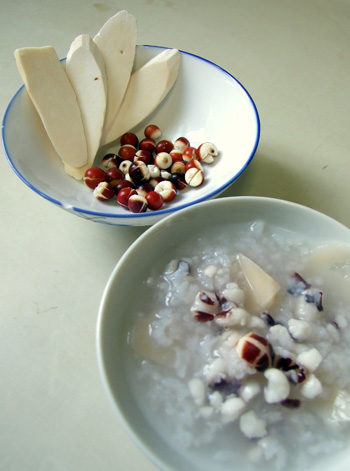
Chinese yam and euryale seed porridge
|
 Stir-fried medlar leaf and pork Stir-fried medlar leaf and pork
Medlar leaf and twig (250g, pick the tender part) and pork meat (250g), green onion (15g, sliced) and ginger (10g, sliced). Wash the leafy vegetables, cut the meat into strips. Add some vegetable oil in a pan and heat up; put in the meat, green onion and ginger to stir-fry until it is 80% cooked, then put in the vegetable and keep stir-frying for 3 minutes; season with salt, soy bean sauce, rice wine or sesame oil to taste; turn off the heat and serve warm. This is beneficial to individuals with red and painful eyes, or dry eyes with blurred vision.
|